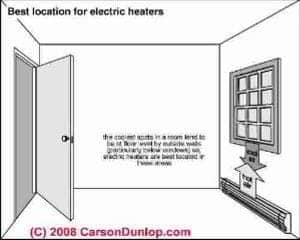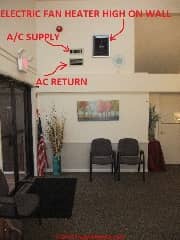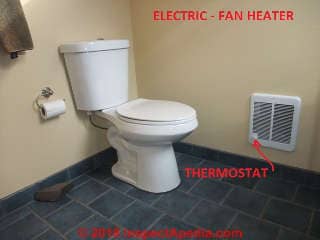 Electric Heater Locations & Clearance Distances
Electric Heater Locations & Clearance Distances
Where to Locate Electric Baseboard, Wall, or Fan Heaters
- POST a QUESTION or COMMENT about proper electrical wiring for electric baseboard heat
Electric baseboard heat placement & clearances:
Electric baseboard heat installation, location, and clearance distance specifications are discussed here.
This article series answers questions about all types of electric heating systems and gives important inspection, safety, and repair advice.
Page top sketch courtesy of Carson Dunlop Associates, a Toronto home inspection, education, and report writing tool firm.
InspectAPedia tolerates no conflicts of interest. We have no relationship with advertisers, products, or services discussed at this website.
- Daniel Friedman, Publisher/Editor/Author - See WHO ARE WE?
Where Should Electric Heaters be Located for Best Performance in a Building?
 While these are not absolute rules, as Carson Dunlop's sketch at page top illustrates, we usually place electric baseboard heaters on an exterior wall.
While these are not absolute rules, as Carson Dunlop's sketch at page top illustrates, we usually place electric baseboard heaters on an exterior wall.
Placing the electric baseboard heater below a window assures heat output from an area of the room wall that will tend to be colder.
Fan heaters are best placed on an interior wall.
Photo: a not so hot location for an electric fan heater. We discuss this installation later on this page.
[Click to enlarge any image]
Electric Baseboard Heat Clearance Distances
- Unobstructed front distance: 1-foot (or more) - 300 mm
- Unobstructed side distance: 6 inches 150 mm
- Unobstructed clearance above the heater: 12 inches
Electric Fan Heater Clearance Distances
- Unobstructed front distance: 3-feet (or more) - 900 mm
- Unobstructed side distance: 6 inches - 150 mm
- Unobstructed clearance above the heater: 12 inches - 300 mm
Night Storage Heater Clearance Distances

- Unobstructed front distance: not given
- Unobstructed side distance: 3" - 75 mm
- Unobstructed clearance above the heater: 12 inches - 300 mm
- Clearance below the heater: Night Storage heaters such as the Dimplex Night Storage heater installed in this Christ Church, New Zealand home shown in our photo above are typically installed with the heater feet in contact with the floor.
See NIGHT STORAGE HEATERS & HEAT SINK RADIATORS for details about this type of electric heat.
The following guidance on using a night storage electric heater is excerpted from that article:
Watch out: prevent contact with a night storage heater surface by children, elderly or frail individuals: the surface of an electric night storage heater can be quit hot.
In New Zealand the surface temperature of a night storage heater must meet the requirements of AS3103 that addresses the safety-covering requirements of electric heating appliances. In Europe, the night storage heater surface temperatures meet a similar standard, quoted from Dimplex:
The surface temperatures of this heater are within the requirements of EN60335-2-61, the European Standard covering the safety requirements for Electric Storage Heaters, and momentary contact with any part of the heater should not cause injury.
However, in order to be effective, heaters of any type do get hot, especially around the air outlet grille. - Dimplex XLN / XLSN Operating Manual
Question: clearance between electric baseboard heater & electrical receptacle
2016/09/18 Dennis said:
I am installing electric hydrostatic baseboard heaters, which they do not get hot enough to damage or burn anything. how far offset must the outlets be from the side of the heater? im on a limited budget, and the last thing I need is to fail inspection.
This question was posted originally
at ELECTRICAL RECEPTACLE HEIGHT & CLEARANCES
Reply:
Dennis,
Clarifying for other readers, I think you mean electric hydronic baseboard heat - that's a more common name for electric baseboard heaters - basically an electric baseboard heat using a sealed unit containing a liquid (silicon oil) that improves thermal mass and heat transfer.
A typical manufacturer's description of the product, using the Qmark HBB 1000 as an example, states:
GO-ANYWHERE DESIGN.
The entire unit mounts flush to any wall and flat on any floor - wood, carpet or tile. The trim, three-inch thick functional design and low operating temperatures allow carpeting to be installed up to and around the baseboard.
Watch out, however about carpeting that blocks air flow through the unit, reducing its heat output and possibly causing overheating.
Watch out: be sure to find and follow the clearances and other instructions for the brand and model of baseboard heater you are installing as those may differ.
Here are some excerpts from the Qmark installation manual:
Do not install heater below an electrical convenience receptacle (outlet).
CAUTION – Heater Operates at High Temperatures. Keep Electrical Cords (including telephone and computer cables), Drapes, and Other Furnishings Away From Heater. For efficient and safe operation, we recommend maintaining a minimum of 6 inches (152 mm) clearance above and in front of the heater at all times. See Figure 2 for minimum clearance requirements for drapery.
Do not install the heater against combustible low-density cellulose fiberboard surfaces, against or below vinyl wall coverings, or below any materials that may be damaged by heat such as vinyl or plastic blinds, curtains, etc.
Important Note: Certain fabrics and materials discolor or may become damaged by heat. Therefore, avoid installing heater against vinyl wall coverings or below plastic or vinyl items such as blinds or vinyl drapes since these items may become damaged by the heated air flowing from heater.
Do not recess heater in wall or install heater inside any type enclosure as this will cause heater to overheat and could create a hazard.
Other warnings and instructions apply - the above are not a complete guide, but they do address your question about electrical outlet proximity to the heater.
If you consider the "do not install below an outlet" advice for this type of heater and that its intent is to avoid overheating an electrical cord that might be plugged in nearby, while we do not have an explicit "side clearance" in the company's advice, it makes sense to me to keep the heater far enough away from a wall receptacle that electrical cords plugged in nearby will not fall in front of or over or touch the heater.
Looking at other Marley heater clearances (2" to drapes in front, 6" to drapes 6" to the side might be enough; it makes sense to ask your local code inspector ahead of time what they will inspect- go armed with the installation manual
Electric Heat Wall Thermostat Location

- Best location: an interior wall different from the wall on which the electric heater has been installed.
- Avoid installing the thermostat directly above the heater; heat from the baseboard will satisfy the thermostat while other room areas are still cool and residual heat from the heater after it has turned off will delay the thermostat's next call for heat as the room cools.
Note: some permanently-installed fan heaters such as used in bathrooms will include the thermostat built into the heater itself. In this case the question of thermostat location is moot.
Watch out: do not block either type of electric heater by furniture, drapes, or anything else.
Not only will you block heat output, thus increasing heating cost, but you may create a fire hazard.
- Don't install an electrical receptacle outlet above an electric heater.
Electric heat is also widely used to add a local source of heat in a problem area (such as a cold entry foyer) and where it would be more trouble and expense to add warm air or hot water or steam heat for that spot.
In my photo above the fan heater installed in this bathroom provides heat for just this small space. It is operated by the thermostatic control knob at the lower right corner of the heater.
Not so Nice Heater Location, Terrible A/C Supply & Return Air Register Locations
 Our photo shows an electric fan heater installed high on the wall of this medical waiting room in Hyde Park, New York. Installing a heat source high on the wall is OK, but not particularly efficient as you're delivering warm air high in the room where warm air wants to stratify in upper room areas anyway.
Our photo shows an electric fan heater installed high on the wall of this medical waiting room in Hyde Park, New York. Installing a heat source high on the wall is OK, but not particularly efficient as you're delivering warm air high in the room where warm air wants to stratify in upper room areas anyway.
This design is made worse by the particularly high ceilings in this room.
The result is that the fan heater has to run longer to heat the room, thus it increases the heating cost.
In the same photo you may notice the terrible placement of the cooling air supply register just inches above the cool air return register in the same room.
Placing these registers close together creates a short circuit that sucks cooling air into the return air inlet before it has cooled the room - increasing cooling costs.
Nevertheless, having waited in this office in both winter and summer weather I [DF] can report that the system "works" - in fact in summer weather the room was uncomfortably cool.
I suspect that the air conditioning air handler is under the roof space in an attic crawl area just behind these two air registers. If that's the case, the installation cost of what was probably a retrofit job would have been much less by taking advantage of the convenience of these supply and return air locations, thus avoiding having to install more ductwork.
We also like to use small electric heat sources in closed crawl spaces and in spots where there is a risk of freezing pipes.
See our article on freeze protection
...
Reader Comments, Questions & Answers About The Article Above
Below you will find questions and answers previously posted on this page at its page bottom reader comment box.
Reader Q&A - also see RECOMMENDED ARTICLES & FAQs
(Nov 14, 2012) Louis Bernardini said: I need a wiring diagram for a Singer model 7165B electric baseboard unit.
...
Continue reading at ELECTRIC HEAT TYPES or select a topic from the closely-related articles below, or see the complete ARTICLE INDEX.
Or see these
Articles on Electric Heat
- ELECTRIC HEAT - home
- COMMON WIRE at THERMOSTATS
- CONVERT LINE to LOW VOLTAGE THERMOSTAT
- ELECTRIC BASEBOARD FEET NEEDED
- ELECTRIC BASEBOARD HEAT INSPECTION
- ELECTRIC BASEBOARD HEAT INSTALL
- ELECTRIC BASEBOARD HEAT SAFETY
- ELECTRIC HEAT DEFECTS LIST
- ELECTRIC HEAT BASEBOARD DIAGNOSE REPAIR
- ELECTRIC HEATER LOCATIONS
- ELECTRIC HEAT TYPES
- ELECTRIC HEATER RECALLS CADET & ENCORE
- NIGHT STORAGE HEATERS & HEAT SINK RADIATORS
- PORTABLE ELECTRIC HEATER FAILURES
- PORTABLE ELECTRIC HEATER SAFETY
- THERMOSTAT WIRING ELECTRIC HEAT
- ELECTRICAL POWER SWITCH FOR HEAT
Suggested citation for this web page
ELECTRIC HEATER LOCATIONS at InspectApedia.com - online encyclopedia of building & environmental inspection, testing, diagnosis, repair, & problem prevention advice.
Or see this
INDEX to RELATED ARTICLES: ARTICLE INDEX to ELECTRIC HEAT
Or use the SEARCH BOX found below to Ask a Question or Search InspectApedia
Ask a Question or Search InspectApedia
Try the search box just below, or if you prefer, post a question or comment in the Comments box below and we will respond promptly.
Search the InspectApedia website
Note: appearance of your Comment below may be delayed: if your comment contains an image, photograph, web link, or text that looks to the software as if it might be a web link, your posting will appear after it has been approved by a moderator. Apologies for the delay.
Only one image can be added per comment but you can post as many comments, and therefore images, as you like.
You will not receive a notification when a response to your question has been posted.
Please bookmark this page to make it easy for you to check back for our response.
IF above you see "Comment Form is loading comments..." then COMMENT BOX - countable.ca / bawkbox.com IS NOT WORKING.
In any case you are welcome to send an email directly to us at InspectApedia.com at editor@inspectApedia.com
We'll reply to you directly. Please help us help you by noting, in your email, the URL of the InspectApedia page where you wanted to comment.
Citations & References
In addition to any citations in the article above, a full list is available on request.
- In addition to citations & references found in this article, see the research citations given at the end of the related articles found at our suggested
CONTINUE READING or RECOMMENDED ARTICLES.
- Carson, Dunlop & Associates Ltd., 120 Carlton Street Suite 407, Toronto ON M5A 4K2. Tel: (416) 964-9415 1-800-268-7070 Email: info@carsondunlop.com. Alan Carson is a past president of ASHI, the American Society of Home Inspectors.
Thanks to Alan Carson and Bob Dunlop, for permission for InspectAPedia to use text excerpts from The HOME REFERENCE BOOK - the Encyclopedia of Homes and to use illustrations from The ILLUSTRATED HOME .
Carson Dunlop Associates provides extensive home inspection education and report writing material. In gratitude we provide links to tsome Carson Dunlop Associates products and services.

